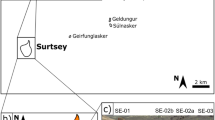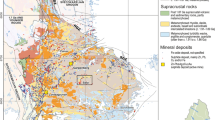Abstract
Samples of crystalline basalt from Site 396 B are all more or less altered, usually in strongly zoned patterns. Evidence has been found for several related or independent alteration stages, including (1) minor localized deuteric (amphibole and mixed clay minerals in miarolitic voids); (2) minor widespread nonoxidizing (pyrite on walls of vugs and cracks); (3) localized diffusion-controlled vug filling (“ glauconite ” in black halos); (4) pervasive low level oxidizing (transformation of titanomagnetite to cation-deficient titanomaghemite); (5) localized diffusion-controlled strongly oxidizing (breakdown of olivine and titanomaghemite in brown zones). Plagioclase and pyroxene are essentially unaltered. Detailed analyses of gray and brown zones in pillow basalts show that low temperature oxidation has proceeded in a step-wise fashion, with the relative stabilities of the igneous minerals controlling the steps. Secondary minerals that crystallized from pore fluids on to the walls of vugs may or may not be related to local alteration of primary phases.
During the most intense stage of alteration, brown oxidation zones grew into basalt fragments behind diffusion controlled fronts. The specific reactions and products of this stage differ among the lithologic units at the site. A model is proposed whereby efficient seawater circulation through the pillow units maintains the pH and the concentrations of Mg2+ and SiO2 dissolved at low levels in pore fluids, so that olivine is replaced by hydrous ferric oxides, and Mg and SiO2 are removed from the system. In the massive basalt unit, circulation is somewhat less effective and Mg and SiO2 are retained in smectites.
Deposition of authigenic minerals in the sequence saponite/Fe-Mn oxides/phillipsite/calcite in vugs and cracks may reflect the gradual closing of the systems and probably signals the end of localized oxidation in parts of the core. Mineral compositions indicate that most of these deposits formed from seawater at very low temperature.
Similar content being viewed by others
References
Andrews AJ (1977) Low temperature fluid alteration of oceanic layer 2 basalts, DSDP Leg 37. Can J Earth Sci 14, 911–926
Andrews AJ (1978) Petrology and geochemistry of alteration in layer 2 basalts, DSDP Leg 37. Unpubl Ph D Thesis, Univ of Western Ontario, pp 327
Bass MN (1976) Secondary minerals in oceanic basalt, with special reference to Leg 34, DSDP. In: Yeats RS, Hart SR, et al (eds) Initial Reports of the Deep Sea Drilling Project, vol 34. Washington, pp 393–431
Bass MN, Moberly R, Rhodes J, Shih C, Church S (1973) Volcanic rocks cored in the Central Pacific. In: Winterer EL, Ewing JI, et al. (eds) Initial Reports of the Deep Sea Drilling Project, vol 17, Washington, pp 429–503
Bentor YK, Kastner M (1965) Notes on the mineralogy and origin of glauconite. J Sediment Petrol 35:155–166
Bernat M, Church TM (1977) Deep-sea phillipsites: trace geochemistry and modes of formation. In: Sand LB, Mumpton FA (eds) Natural zeolites: occurence, properties, and use. p 259–267
Berner RA (1975) The role of magnesium in the crystal growth of calcite and aragonite from sea water. Geochim Cosmochim Acta 39:489–504
Bischoff JL, Dickson FW (1975) Seawater-basalt interaction at 200° C and 500 bars: implications for origin of sea-floor heavymetal deposits and regulation of seawater chemistry. Earth Planet Sci Lett 25:385–397
Böhlke JK, Honnorez J, Honnorez-Guerstein B-M, Petersen N, Muehlenbachs K (in press) Correlation of rock chemistry, magnetic properties, and O-isotope ratios with alteration patterns in basalts from Site 396 B, DSDP. J Geophys Res, Special issue
Breck WG (1974) Redox levels in the sea. In: Goldberg ED (ed) The Sea, Vol 5 Wiley and Sons, New York, pp 153–179
Christensen NI, Salisbury MH (1973) Velocities, elastic moduli, and weathering-age relations for Pacific Layer 2 basalts. Earth Planet Sci Lett 19:461–470
Colby JW (1971) MAGIC IV-A computer program for quantitative electron microprobe analyses: Bell Laboratories
Deer WA, Howie RA, Zussman J (1962) Rock-Forming Minerals, Vol 1–4. Wiley and Sons, New York
Dmitriev L, Hiertzler JR, et al. (1978) Initial Reports of the Deep Sea Drilling Project, Vol. 46. Washington, pp 15–49
Drever JI (1974) 10. The Magnesium Problem. In: Goldberg EG (ed) The Sea. Vol 5, Wiley and Sons, New York, pp 337–357
Field CW, Dymond JR, Heath GR, Corliss JB, Dasch EJ (1976) Sulfur isotope reconnaissance of epigenetic pyrite in ocean-floor basalts, Leg 34 and elsewhere. In: Yeats RS, Hart SR, et al (eds) Initial Report of the Deep Sea Drilling Project, vol 34. Washington, pp 381–384
Frey FA, Bryan WB, Thompson G (1974) Atlantic Ocean floor: geochemistry and petrology of basalts form Legs 2 and 3 of the Deep Sea Drilling Project. J Geophys Res 79:5507–5527
Galli E, Ghittoni AGL (1972) The crystal chemistry of phillipsites. Am Mineral 57:1125–1145
Garlick GD, Dymond JR (1970) Oxygen isotope exchange between volcanic materials and ocean water. Geol Soc Am Bull 81:2137–2142
Goldberg ED (1965) Minor elements in seawater. In: Riley JP, Skirrow G (eds) Chemical Oceanography, vol 1. Academic Press, London, pp 163–196
Goldsmith JR, Graf DL, Heard HC (1961) Lattice constants of the Ca-Mg carbonates. Am Mineral 46:453–457
Hart R (1973) A model for chemical exchange in the basalt-seawater system of oceanic layer II. Can J Earth Sci 10:799–816
Hart SR (1969) K, Rb, Cs contents and K/Rb, K/Cs ratios of fresh and altered submarine basalts. Earth Planet Sci Lett 6:295–303
Hay RL (1966) Zeolites and zeolitic reactions in sedimentary rocks. Geol Soc Am Spec Pap 85:130
Helgeson HC, MacKenzie FT (1970) Silicate-sea water equilibria in the ocean system: Deep-Sea Research 17:877–892
Hodges FN, Papike JJ (1977) Petrology of basalts, gabbros and peridotites from DSDP Leg 37. In: Aumento F, Melson WG, et al (eds) Initial Reports of the Deep Sea Drilling Project, Vol 37. Washington, p 711–719
Honnorez J (1967) La Palagonitization: l'altération sous-marine du verre volcanique basique de Palagonia (Sicile). Ph D Thesis, Univ of Bruxelles
Honnorez J (1972) La Palagonitization: l'altération sous-marine du verre volcanique basique de Palagonia (Sicile). Vulkaninstitut I. Friedlaender, Zürich, Publ No 9, 132 pp. Birkhauder, Basel
Honnorez J (1978) Factors controlling the rate and intensity of seafloor alteration (Abstr). EOS Trans Am Geophys Union 59:1111
Honnorez J (1980) The aging of the oceanic crust at low temperature. In C Emiliani (ed). The Sea. John Wiley Interscience, New York 7:50
Honnorez J, Böhlke JK, Honnorez-Guerstein B-M (1978a) Petrographical and geochemical study of the low temperature sub marine alteration of basalt from Hole 396 B, Leg 46. In: Dmitriev L, Hiertzler JR, et al (eds) Initial Reports of the Deep Sea Drilling Project, Vol 46. Washington, p 299–329
Honnorez J, Böhlke JK, Honnorez-Guerstein B.-M, Petersen N (1978 b) Correlation between the changes in mineralogy, chemistry and magnetic properties of basalts from Leg 46 with low temperature submarine alteration. Initial Reports, of the Deep Sea Drilling Project, Vol 46. Washington, p 371–376
Honnorez J, Muehlenbachs K, Petersen N (in press) Correlation between the changes due to alteration in mineralogy, chemistry, magnetic properties and oxygen isotope composition of basalts from Leg 54. Initial Reports of the Deep Sea Drilling Project, Vol 54. Washington
Irving E (1970) The Mid-Atlantic Ridge at 45° N. XIV Oxidation and magnetic properties of basalt: review and discussion. Can J Earth Sci 7:1528–1538
Johnson HP, Atwater T (1977) Magnetic study of basalts from the Mid-Atlantic Ridge, latitude 37° N. Geol Soc Am Bull 88:637–647
Johnson HP, Hall JM (1978) A detailed rock magnetic and opaque mineralogy study of the basalts from the Nazca Plate. R Astr Soc Geophys J 52:45–64
Katz A (1973) The interaction of magnesium with calcite during crystal growth at 25°–90° C and one atmosphere: Geochim Cosmochim Acta 37:1563–1586
Kempe DRC (1974) The petrology of the basalts, Leg 26. In: TA Davies, BP Luyendyk et al, (eds) Initial Reports of the Deep Sea Drilling Project, Vol 26. Washington, p 465–504
Kirkpatrick RJ (1978) Processes of crystallization in pillow basalts, Hole 396 B, DSDP Leg 46. In: Dmitriev L, Hiertzler J et al, (eds) Initial Reports of the Deep Sea Drilling Project, Vol 46. Washington, p 271–282
Krismannsdóttir H (1978) Alteration of basaltic rocks by hydrothermal activity at 100°–300° C. Int Clay Conf, MM Mortland and VC Farmer (eds), p 359–367
Krouse HR, Brown HM, Farquharson RB (1977) Sulphur isotope compositions of sulphides and sulphates, DSDP Leg 37. Can J Earth Sci Lett 14:787–793
MacRae ND, Fleet ME, Andrews AJ (1977) An occurrence of secondary sulfides from Leg 37 basalts. Contrib Mineral Petrol 63:309–317
Marshall M, Cox A (1972) Magnetic changes in pillow basalt due to sea-floor weathering. J Geophys Res 77:6459–6469
Moiola RJ (1970) Authigenic zeolites and K-feldspar in the Esmeralda Formation, Nevada. Am Mineral 55:1681–1691
Moore JG (1966) Rate of palagonitization of submarine basalt adjacent to Hawaii. US Geol Surv Prof Pap 550-D: 163–171
Morse J, Cook N (1978) The distribution and form of phosphorus in North Atlantic Ocean deep sea and continental slope sediments; Limnology and Oceanography 23:825–830
Mottl MJ (1976) Chemical exchange between seawater and basalt during hydrothermal alteration of the oceanic crust. Ph D Dissertation, Harvard University, 188 pp
Mottl MJ, Holland HD (1975) Basalt-seawater interaction, sea floor spreading and the dolomite problem (Abstr). EOS Trans Am Geophys Union 56:1074
Nesbitt HW, Bricker OP (1978) Low temperature alteration processes affecting ultramafic bodies. Geochim Cosmochim Acta 42:403–409
Petersen N (1978a) Low temperature alteration of the magnetic minerals in ocean floor basalts. Paper presented at the Second Maurice Ewing Memorial Symposium, Arden House. Harriman, New York
Robinson PT, Flower MFJ, Schmincke HU, Ohnmacht W (1977) Low temperature alteration of oceanic basalts, DSDP Leg 37. In: Aumento F, Melson WG et al (eds) Initial Reports of the Deep Sea Drilling Project, Vol 37, Washington, p 775–794
Scheidegger KF, Stakes DS (1977) Mineralogy, chemistry and crystallization sequence of clay minerals in altered tholeiitic basalts from Peru Trench. Earth Planet Sci Lett 36:413–422
Scott RB, Hajash A (1976) Initial submarine alteration of basaltic pillow lavas: a microprobe study. Am J Sci 276:408–501
Seyfried WE Jr (1977) Seawater-basalt interaction from 25°–300° C and 1–500 bars: implications for the origin of submarine metalbearing hydrothermal solutions and regulation of ocean chemistry. Ph D Dissertation, University of Southern California, 242 pp
Seyfried WE, Shanks WC, Bishoff JL (1976) Alteration and vein formation in Site 321 basalts. In: Yeats RS, Hart SR et al (eds) Initial Reports of the Deep Sea Drilling Project, Vol 34. Washington, p 385–392
Sheppard R, Gude A, III, Griffin JJ (1970) Chemical composition and physical properties of phillipsite from the Pacific and Indian Oceans. Am Mineral 55:2053–2062
Sorem RK, Foster AR (1973) Mineralogical, chemical and optical procedures and standards for study of growth features and economic potential of manganese nodules: Inter-Univ Program of Research on Ferromanganese Deposits of the Ocean Floor Report (unpubl), p 23–43
Stakes DS (1978) Geochemical mass balance model for saponite and celadonite formation in altered layer II basalts (Abstr). EOS Trans Am Geophys Union 59:1111
Stonecipher SA (1977) Chemistry of deep-sea Phillipsite, clinoptilolite and host sediments. In: Sand LB and Mumpton FA (eds) Natural Zeolites: Occurrence, Properties, Use. Pergamon Press, Oxford, 1978
Tómasson J, Kristmannsdóttir H (1972) High temperature alteration minerals and thermal brines, Reykjanes, Iceland. Contrib Mineral Petrol 36:123–134
Thompson G (1973) A geochemical study of the low temperature interaction of seawater and oceanic igneous rocks. EOS Trans Am Geophys Union 54:1015–1019
Thorez J (1975) Phyllosilicates and Clay Minerals (A Laboratory Handbook for their X-Ray diffraction Analysis: G Lelotte, Dison (Belgium), 582 pp
Weaver CE, Pollard LD (1973) The Chemistry of Clay Minerals. Dev Sedimentol, Vol 15. Elsevier, Amsterdam, 213 pp
Wolery TJ, Sleep NH (1976) Hydrothermal circulation and geochemical flux at mid-ocean ridges. J Geol 84:249–275
Author information
Authors and Affiliations
Rights and permissions
About this article
Cite this article
Böhlke, J.K., Honnorez, J. & Honnorez-Guerstein, B.M. Alteration of basalts from site 396 B, DSDP: Petrographic and mineralogic studies. Contr. Mineral. and Petrol. 73, 341–364 (1980). https://doi.org/10.1007/BF00376628
Accepted:
Issue Date:
DOI: https://doi.org/10.1007/BF00376628




